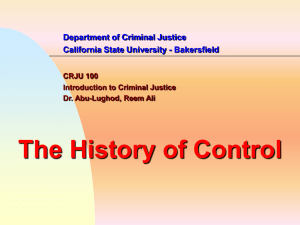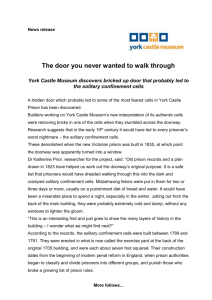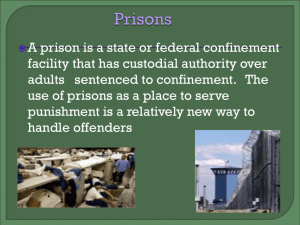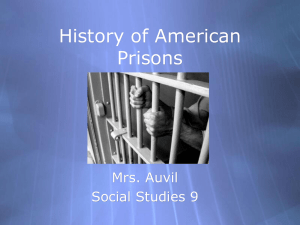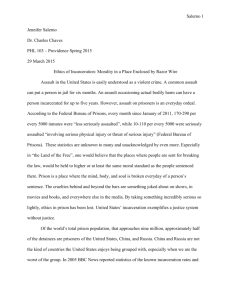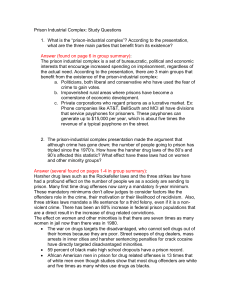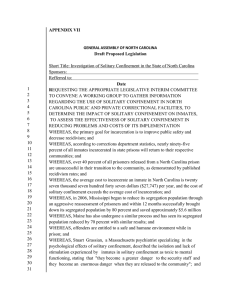CORRECTIONS
advertisement
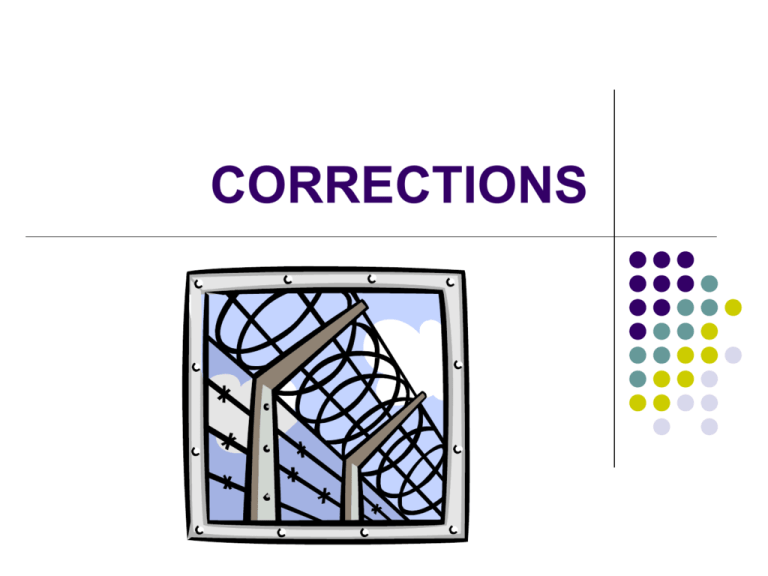
CORRECTIONS DEVELOPMENT OF CORRECTIONS Corrections is the number of programs, services, facilities and organizations responsible for the management of people accused or convicted of criminal offenses PRIOR TO 1800’s PHYSICAL FLOGGING BRANDING MAIMING Lex talionis— Law of retaliation “The law of the claw” JAILS Jails were for holding people for court or to pay a debt Death for: Pick pocketing Burglary Robbery Horse stealing JOHN HOWARD Sheriff of Bedfordshire, England Observed prisons Concerned about conditions Wrote “The State of Prisons In England And Wales” in 1777 PENITENTIARY ACT OF 1779 In response to John Howard’s book Called for the creation of penitentiaries Intended to punish criminals by isolating them from society PENITENTIARY A PRISON PLACE OF CONFINEMENT WHERE THOSE CONVICTED OF A STATE OR FEDERAL FELONY VIOLATION SERVE THEIR TIME DERIVES FROM PENITENCE PUNISH AND REFORM Penitentiaries to be based on 4 principles: A secure and sanitary building Inspection to ensure that offenders followed the rules Abolition of the fees charged offenders for their food A reformatory theme REFORM IN THE U.S. New policies reflected ideas expressed in the Declaration of Independence Optimistic view of the human race TWO MAJOR PRISON SYSTEMS AUBURN PENNSYLVANIA WALNUT STREET JAIL Benjamin Rush advocated the penitentiary as a replacement for capital and corporal punishment Pennsylvania System---1790 “Solitary confinement to hard labor and a total abstinence from spirituous liquors will prove the most effectual means of reforming these unhappy creatures” Separate confinement based on 5 principles: No vengeful treatment, but hard suffering could change their lives Solitary confinement prevents corruption inside prison Offenders will reflect and repent Solitary confinement is punishment Solitary confinement is economical 8 dark cells 6x8x9 Eastern Penitentiary Opened in 1829 Each prisoner ate, slept, worked and received religious instruction in own cell Prisoners suffered mental breakdowns Separate confinement declines because of over crowding Separate confinement was abolished in 1913 NEW YORK SYSTEM Opened in Auburn in 1819 CONGREGATE SYSTEM—isolated at night, but worked with other inmates during the day under a rule of silence. They were not even to exchange glances CONTRACT LABOR SYSTEM—inmates’ labor was sold on a contractual basis to private employers Prison stripes began REFORMATORY MOVEMENT Penitentiaries were failing to achieve rehabilitation Middle of the 19th Century National Prison Association’s Declaration of Principles Sentences became indeterminate Proof of reformation rather than just serving time Crime was a moral disease REFORMATORY FOR KIDS Elimira Reformatory in New York First time felons between the ages of 16-30 Mark System—had to earn a good mark for parole WOMEN’S PRISONS 1813 ELIZABETH FRY who was a Quaker First person to push for press for changes Three principles guided reform Separation of female prisoners Provisions of care in keeping with the needs of women Management of women’s prisons by female staff PROBATION 1841 COBBLER----JOHN AUGUSTUS FATHER OF PROBATION 18 YEAR CAREER REHABILITATION MODEL 1930’s Emphasizes the need to restore an offender to a constructive place in society CRIMINOLOGY THE SCIENTIFIC APPROACH TO STUDYING THE NATURE, EXTENT, CAUSE AND CONTROL OF CRIMINAL BEHAVIOR PENOLOGY STUDY OF PUNISHMENT PRISON MANAGEMENT COMMUNITY MODEL 1960’S------1970’S Reintegration into the community Vocational and educational programs FURMAN V GEORGIA AMERICAN JUSTICE VIDEO MORATORIUM ON DEATH PENALTY 1972-1976 DEATH PENALTY MOST COMMON METHOD USED?? CA, ALASKA, HAWAII OR MAINE STILL HAVE THE DEATH PENALTY? CRIME CONTROL 1970’S TO PRESENT Determinate sentences Mandatory sentences Punitive agenda INCARCERATION CONFINEMENT IN JAIL OR PRISON CLASSIFICATIONS: LOW, MEDIUM, MAX HIGHEST FEDERAL PRISON SUPER MAX----44 states have one NOTORIUS OFFENDERS PROBLEM OFFENDERS PRIVATE PRISONS PRAIRIE CORRECTIONAL FACILITY CLOSED 2010 APPLETON MN 1600 BEDS CORRECTIONS CORPORATION OF AMERICA BOOKING PROCEDURES STATE TAKES POSSESSION OF ALL PROPERTY INCLUDES: MENTAL, MEDICAL AND PHYSICAL EVALUATION NOT: FINANCIAL, SOCIAL OR EDUCATIONAL RIGHTS OF OFFENDERS NO CRUEL AND UNUSUAL PUNISHMENT NO LIVING CONDITIONS THAT VIOLATE BASIC HUMAN DIGNTY RIGHT TO PHYSICAL AND MENTAL HEALTH RIGHT TO RELIGIOUS WORSHIP DISABLED INMATES---AMERICANS WITH DISABILITIES ACT (ADA) NO RIGHT TO FREE SPEECH RIGHT TO ASSEMBLY RIGHT TO BEAR ARMS 4TH AMENDMENT
